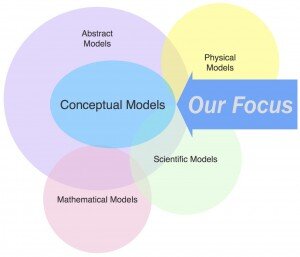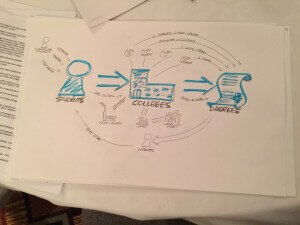Summary: Kaarin Hoff, Joe Elmendorf and Andrew Hinton gave a workshop at the IA Summit on practical modeling, a useful tool for getting at theWhat of a project.
Karin Hoff was one of the co-presenters of the Practical Modeling Workshop.
The Information Architecture Summit is always a wonderful mind feast, and this year was no exception. Joe Elmendorf, Andrew Hinton, and Kaarin Hoff had the pleasure of teaching a half-day pre-conference workshop titled Practical Modeling: Making the Invisible Visible. Below you’ll find some of the main points and highlights from the session, as well as the presentation deck.
Practical Modeling Workshop Intro
There are many sorts of modeling, including things like physical scale models of buildings, mathematical and statistical models. These overlap in many ways.
But we’re talking about conceptual models.
Conceptual models help us do some important things really well, like:
Make concepts into visual objects we can manipulate
Allow us to explore their relationships
Let us work with parts and aspects of complex systems
We emphasize this is practical modeling because there’s a misconception that conceptual work isn’t practical. But, in fact, all these approaches are practical, when used for the right purposes. So why model?
Because IA is BIG.
Information architecture isn’t just about designing labels, links, and content arrangement … and it’s not just about websites. It has to do with the way language acts as a sort of infrastructure. It addresses meanings and their relationships and how those create structures. And a lot of that is driven by the way the organization understands and talks about itself and what it is putting into the environment. The questions needed to get at navigation and filters and interfaces are the same questions that get at the core of an organization. Modeling can help expose all of that and help align a product or offering to deliver what the business needs and the user wants. We talk about modeling because it is the most useful tool in our tool box to get at the WHAT.
Establishing the WHAT before the HOW saves time, money, and frustration. The complex ecosystems we’re designing for these days require a strategy for understanding the whole, and the relationships between all of its parts.
source: http://tombanwell.blogspot.com/2010/09/olifant-neoprene-trunk-hose.html
We hear a lot from folks that their work environment just can’t support modeling. We’d argue you’re too busy not to model. No matter if you work in an Agile or waterfall environment, if you’re involved in the entire project or just a portion of it, modeling can help you in your work.
We realize your project plan may include no time for “modeling” as a phase, but you can do it as part of your other work, or as part of the collaborations and conversations you have with stakeholders and team members. Just getting up to a whiteboard and modeling the ideas being discussed in real time can be most of the modeling you need — or the start of a new, official design artifact. Whether we know it or not, we already have various assumptions that serve as accidental, hidden models anyway. It’s better to bring these invisible assumptions of a group out into the open, and model them explicitly. Because, ultimately, models become molds for making.
Try It!
How do you get started? Just start making visible what you know. Play with circles. Use question marks. Use arrows. Capitalize on Venn diagrams. As you organize what you know, new information will be created! You’ll see new connections and find new questions. We’re fans of very lightweight models that don’t need to subscribe to detailed methodologies. Getting ideas, priorities, or anything else relevant into something visible is the first step.
A few tips: Know that a model can never be the whole truth. Use multiple models to get at different issues. Don’t be afraid to leave out details—concentrate on the big issues you need alignment on.
Keep the parts movable as long as possible. And be careful of trying to make it too pretty; sometimes, pretty is dangerous. If you make your model too pretty, too perfect, you won’t want to change it and neither will anyone else. These are objects for discovery, they are suppose to be messy and pliable, so embrace it.
(is this model yours? let us know!)
You can try this at home with one of the hands-on activities we did in the workshop: Model your morning coffee ecosystem. How do you get coffee in the morning? What is the bigger system in which you get coffee? Here are some of our favorite models produced by workshop attendees. (Unfortunately, we didn’t get the names of their creators when we took these snapshots, so let us know if you made any of these!)
(is this model yours? let us know!)
We also did a second, more complex activity: we gave attendees a document full of complicated, messily captured notes from a pretend project. The attendees were to prepare for their first meeting with the client by modeling the important structures, issues, patterns, or open questions they could glean strictly through using these early discovery notes. (The website of this fictional organization was so out of date, it wouldn’t be useful for background.)
It was a HARD problem. The attendees did a great job wrestling with it independently, then asking for input and help from their tables. Even with the all-too-real frustrations, the group had a fun time.
An example of the excellent work done during the workshop. By Richard Dalton @mauvyrusset
Thanks to all our attendees, and to the IA Summit conference, for giving us the opportunity to share Practical Modeling.
Learn More
If you are interested in learning more ways to use modeling in your IA practice, contact us is you want to learn more about practical modeling.
For version with speaker notes, see: http://www.slideshare.net/kaarinh/practical-modeling-making-the-invisible-visible







